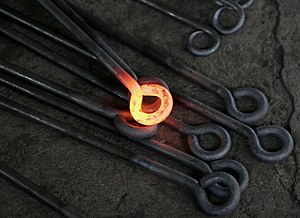Chemical :
Metals are usually inclined to form cations through electron loss reacting with oxygen in the air to form oxides over changing timescales (iron rusts over years, while potassium burns in seconds). Examples:
- 4 Na + O2 → 2 Na2O (sodium oxide)
- 2 Ca + O2 → 2 CaO (calcium oxide)
- 4 Al + 3 O2 → 2 Al2O3 (aluminium oxide)
- The transition metals (such as iron, copper, zinc and nickel) take much longer to oxidize. Others, like palladium, platinum and gold, do not react with the atmosphere at all. Some metals form a barrier layer of oxide on their surface which cannot be penetrated by further oxygen molecules and thus retain their shiny appearance and good conductivity for many decades (like alumunium, some steels and titanium). The oxides of metals are generally basic, as opposed to those of nonmetals, which are acidic.
 Gallium crystal
Gallium crystal
Painting, anodizing or plating metals are good ways to prevent their corrosion. However, a more reactive metal in the electrochemical series must be chosen for coating, especially when chipping of the coating is expected. Water and the two metals form an elecrtocchemical cell, and if the coating is less reactive than the coatee, the coating actually promotes corrosion.
Phisical :
Metals in general have high lectrical conductivity, thermal conductivity, luster and density, and the ability to be deformed under stress without cleaving. While there are several metals that have low density, hardness, and melting points, these (the alkali and alkaline earth metals) are extremely reactive, and are rarely encountered in their elemental, metallic form. Optically speaking, metals are opaque, shiny and lustrosus. This is due to the fact that visible lightwaves are not readily transmitted through the bulk of their microstructure. The large number of free electrons in any typical metallic solid (element or alloy) is responsible for the fact that they can never be categorized as transparent materials.
The majority of metals have higher densities than the majority of nonmetals. Nonetheless, there is wide variation in the densities of metals; lithium is the least dense solid element and osmium is the densest. The metals of groups I A and II A are referred to as the Light metals because they are exceptions to this generalization. The high density of most metals is due to the tightly packed crystal lattice of the metallic structure. The strength of metallic bonds for different metals reaches a maximum around the center of the transition series, as those elements have large amounts of delocalized electrons in a metallic bond.Electrical :
The electrical and thermal conductivity of metals originate from the fact that in the metallic bond, the outer electrons of the metal atoms form a gas of nearly free electrons, moving as an electron gas in a background of positive charge formed by the ion cores. Good mathematical predictions for electrical conductivity, as well as the electrons' contribution to the heat capacity and heat conductivity of metals can be calculated from the fre electron model, which does not take the detailed structure of the ion lattice into account.
When considering the exact band structure and binding energy of a metal, it is necessary to take into account the positive potential caused by the specific arrangement of the ion cores - which is periodic in crystals. The most important consequence of the periodic potential is the formation of a small band gap at the boundary of the Brillouin zone. Mathematically, the potential of the ion cores can be treated by various models, the simplest being the nearly free electron model.
Mechanical :Mechanical properties of metals include ductility, which is largely due to their inherent capacity for plastic deformation. Reversible elasticity in metals can be described by Hooke's Law for restoring forces, where the stress is linearly proportional to the strain. Forces larger than the elastic limit, or heat, may cause a permanent (irreversible) deformation of the object, known as plastic deformation or plasticity. This irreversible change in atomic arrangement may occur as a result of:
- The action of an applied force. An applied force may be tensile (pulling) force, compressive (pushing) force, shear, bending or torsion (twisting) forces.
or
- A change in temperature. A temperature change may affect the mobility of the structural detects such as grain boundaries, point vacancies, line and screw dislocations, stacking faults and twins in both crystalline and non-crystalline solids. The movement or displacement of such mobile detects is thermally activated, and thus limited by the rate of atomic diffusion.

